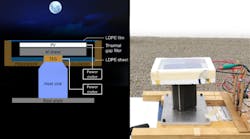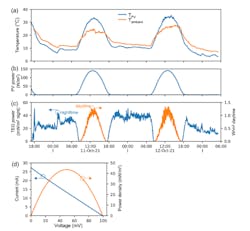Hybrid PV+TEG Device Yields Day/Night Solar Harvesting
What you’ll learn:
- How impinging solar energy and radiative cooling can be used for energy harvesting.
- How a single device and enclosure was fabricated to efficiently harvest this day/night thermal flow.
- How much power and no-load voltage was developed by the arrangement?
Photovoltaic (PV) devices (solar cells) are viable when the sun shines, but nighttime is another story, of course. However, a device that also could function efficiently as a thermoelectric generator (TEG) using radiative cooling at night would be an important improvement and advance for 24-hour harvesting.
That’s what a team at Stanford University has developed. While they acknowledge that this isn’t the first such hybrid-harvesting device, they maintain that its performance of 50-mW/m2 nighttime power generation with a clear night sky and an open-circuit voltage of 100 mV is far superior to previous efforts.
Radiative generation is possible because the Earth’s atmosphere is transparent in the mid-infrared wavelength range and there’s outgoing radiative heat flow from Earth to outer space (Fig. 1).
The energy flux components involved are the downward thermal radiation of the atmosphere absorbed by the PV cell (Patm), the upward thermal radiation of the PV cell (Prad), the heat flux through the TEG from the ambient to the PV cell (PTE), and the heat from the surrounding ambient to the PV cell that doesn’t go through the TEG (Ploss).
Construction
Their device used a SunPower C-60 monocrystalline silicon solar cell with a surface area of 153 cm2 (Fig. 2). An aluminum sheet underneath the cell helps to improve the thermal conduction across the cell’s surface and enables effective heat transfer to and from the smaller TEG module (Marlow TG12–4) with a 9-cm2 surface area.
They chose this surface area for the TEG in relation to that of the PV cell to maximize TEG power generation. This was accomplished by minimizing the “parasitic” thermal conduction between air and the PV cell and the thermal conduction through the TEG itself.
Finally, they built an air-insulated chamber from polystyrene sheets around the PV cell with an opening at the bottom for heat-sink connection, also to minimize parasitic heat flow with the ambient temperature. The chamber is covered on the top with a low-density polyethylene (LDPE) film, which is transparent in both the visible and mid-infrared wavelength ranges.
“You want the thermoelectric to have very good contact with both the cold side, which is the solar cell, and the hot side, which is the ambient environment,” said author Sid Assawaworrarit. “If you don’t have that, you’re not going to get much power out of it.” Added do-author Zunaid Omair, “What we managed to do here is build the whole thing from off-the-shelf components, have a very good thermal contact, and the most expensive thing in the whole setup was the thermoelectric itself.”
Evaluation
The team tested the unit over a three-day period during which sky conditions ranged from clear to cloudy. They measured the TEG power, PV cell power, and temperatures of PV, heat sink, and ambient, as well as the generated electrical power, using a maximum power point tracking algorithm.
Temperature measurements show that the PV cell heats up from absorbing the solar radiation during the daytime (Fig. 3). At midday, the PV cell reached a peak temperature difference of around 15°C above ambient. The observed daytime temperature difference correlates with the PV cell power. During nighttime, in the absence of solar radiation, they saw the effects of radiative cooling of the PV cell in its temperature, which fell below ambient.
The TEG function isn’t “idle” during the day, either, as solar heating elevates the PV cell temperature above ambient, resulting in TEG power of around 20 mW at midday—approximately 1% of the PV cell power. During the nighttime, the TEG power reached a sustained level of around 0.7 mW on the night of October 11. Normalizing these peak numbers to the PV cell’s area gives 1.3 W/m2 for daytime and 50 mW/m2 for nighttime.
The team notes that other reported PV-TEG devices provided an open-circuit voltage of 9 mV, whereas this device had a significantly higher voltage (100 mV). Meanwhile, the corresponding electrical power is two orders of magnitude greater due to the quadratic scaling effect.
The work is detailed in a well-written paper “Nighttime electric power generation at a density of 50 mW/m2 via radiative cooling of a photovoltaic cell” published in Applied Physics Letters. It includes the expected solar and thermal analysis, modeling, and simulation; results were fairly close to the model predictions. There’s also a Supplementary Material file that provides more details on construction, test, and results.



